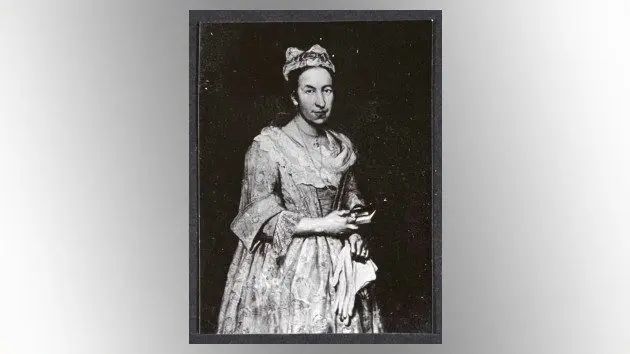
(LONDON) — An 18th-century portrait stolen by the Nazis during WWII is believed to have resurfaced in the most unexpected place: hanging above a sofa in a coastal Argentinian home and discovered not by law enforcement or a museum, but spotted in a photo on a real estate website.
The painting, “Portrait of a Lady” by Italian baroque artist Giuseppe Vittore Ghislandi, belonged to Jacques Goudstikker, a prominent Dutch-Jewish art dealer whose collection of more than 1,100 works was seized after the Nazi invasion of the Netherlands in 1940. Senior Nazi officials, including Hermann Göring, acquired hundreds of pieces, according to the Cultural Heritage Agency of the Netherlands (RCE).
The potential discovery is the result of years of work by Dutch daily newspaper Algemeen Dagblad (AD) investigative journalists Cyril Rosman, Paul Post and Peter Schouten, who have been pursuing the case for nearly a decade.
Rosman said the team began tracing Friedrich Kadgien, Göring’s financial adviser and close confidant, several years ago.
“Kadgien escaped to South America at the end of the war,” Rosman told ABC News. “We knew from archival documents that he brought diamonds, jewelry, and two stolen paintings with him. We’ve spent years trying to piece together his life here and where those paintings ended up.”
Kadgien died in Buenos Aires in 1978. His two daughters inherited properties in Mar del Plata, where the investigation eventually led the AD journalists.
After years of dead ends, the AD team resolved to make one final attempt. They sent Peter Schouten, AD’s correspondent in Argentina, to visit the property.
“I rang the bell. Nobody answered but we saw movement inside,” Schouten recalled. “Then we noticed a ‘For Sale’ sign in the garden.”
Back at his hotel, Schouten looked up the property listing together with his husband, a producer for international media who often assists in his investigations.
“We were scrolling through the photos when my husband suddenly said, ‘Look, isn’t that the painting?’” Schouten said. “I told him, ‘No, that can’t be true. The Dutch government has been looking for this painting for 80 years … it can’t just be hanging above a sofa in Mar del Plata.’ But there it was.”
Rosman, reviewing the same images from the Netherlands, had the same reaction.
“I was scrolling through the listing, looking for photos of the father or maybe some old documents,” Rosman said. “I didn’t expect to find one of the paintings we’d been searching for just sitting there in the living room. It was surreal.”
AD immediately sent the images to the RCE, which maintains official records of Nazi-looted art. Annalies Kool, a provenance researcher at RCE, told ABC News that the agency is “almost certain” the painting is the missing “Portrait of a Lady” but cannot 100% confirm it without examining the work in person.
“According to post-war declaration forms, we know that Kadgien possessed this painting,” Kool said. “Given that he fled to Argentina after the war and we now see it hanging in the living room of his daughters, we assume it has remained within the family for the past 80 years.”
Kool explained that the RCE cross-referenced the photo with the original wartime records. “The measurements match, the composition matches, and visually it aligns with the archival images,” she said. “But we would need to examine the back of the painting to confirm. There could be labels or marks proving it came from the Goudstikker collection.”
However, AD didn’t rely solely on the real estate listing photos to identify the painting. “We obtained additional images from inside the house from a separate source,” Schouten confirmed. “That gave us the second verification we needed before publishing.”
AD said they repeatedly attempted to speak with Kadgien’s daughters via email, Instagram, and WhatsApp. “After weeks, one of them finally responded,” Schouten said. “She asked what we wanted, said she was busy, and then blocked us.”
Shortly afterward, the listing real estate agency, Robles Casas y Campos, removed the photos showing the painting, as well as the entire listing itself.
Goudstikker’s heirs are represented by U.S. attorneys Yael Friedman and Amelia Cuneo of Friedman, Norman & Friedland, LLP. Friedman confirmed to ABC News that their client, Marei von Saher, Goudstikker’s 81-year-old daughter-in-law and sole heir, intends to pursue a formal restitution claim for “Portrait of a Lady.”
“Our client does intend to make a claim,” Friedman said. “She is the sole heir of Jacques Goudstikker’s estate and her goal is to recover the artworks that were looted by the Nazis from her father-in-law.”
Kool also said that a second missing painting – a 17th-century floral still life by Dutch artist Abraham Mignon – was listed in Kadgien’s possession in post-war declarations. Investigators believe it appears in a 2012 Facebook photo posted by one of Kadgien’s daughters, though its ownership and provenance remain unclear.
Friedman clarified that their claim will only target the Ghislandi portrait, not the second Mignon painting, because that work was not part of the Goudstikker collection.
“I have been on this quest since the late 1990s. My family’s goal is to locate and recover each and every artwork looted from Jacques Goudstikker’s collection and restore his legacy, von Saher told ABC News in a statement provided through her lawyers.
“This is the kind of case you dream of,” said Arthur Brand, the Dutch art detective often called “the Indiana Jones of the art world.” “A painting stolen in WWII, thought lost for decades, suddenly pops up on a real estate website in Argentina, hanging above a sofa,” Brand said. “You can’t write a better script.”
Brand added that the discovery highlights the unpredictable nature of recovering looted art: “You can find them anywhere – auction catalogues, archives, attics, even real estate listings.”
Rosman believes this case is only the beginning. “Hundreds, maybe thousands, of Nazi fugitives fled to Argentina after the war,” he said. “Who knows how many more looted artworks ended up here, quietly passed down through families?”
Brand agreed: “This case shows something important,” he said. “Thousands of Nazi-looted works are still out there, hanging in living rooms, passed down quietly through families. Argentina was a haven for many who fled Europe after the war – who knows how many masterpieces are still hidden here?”
Copyright © 2025, ABC Audio. All rights reserved.



